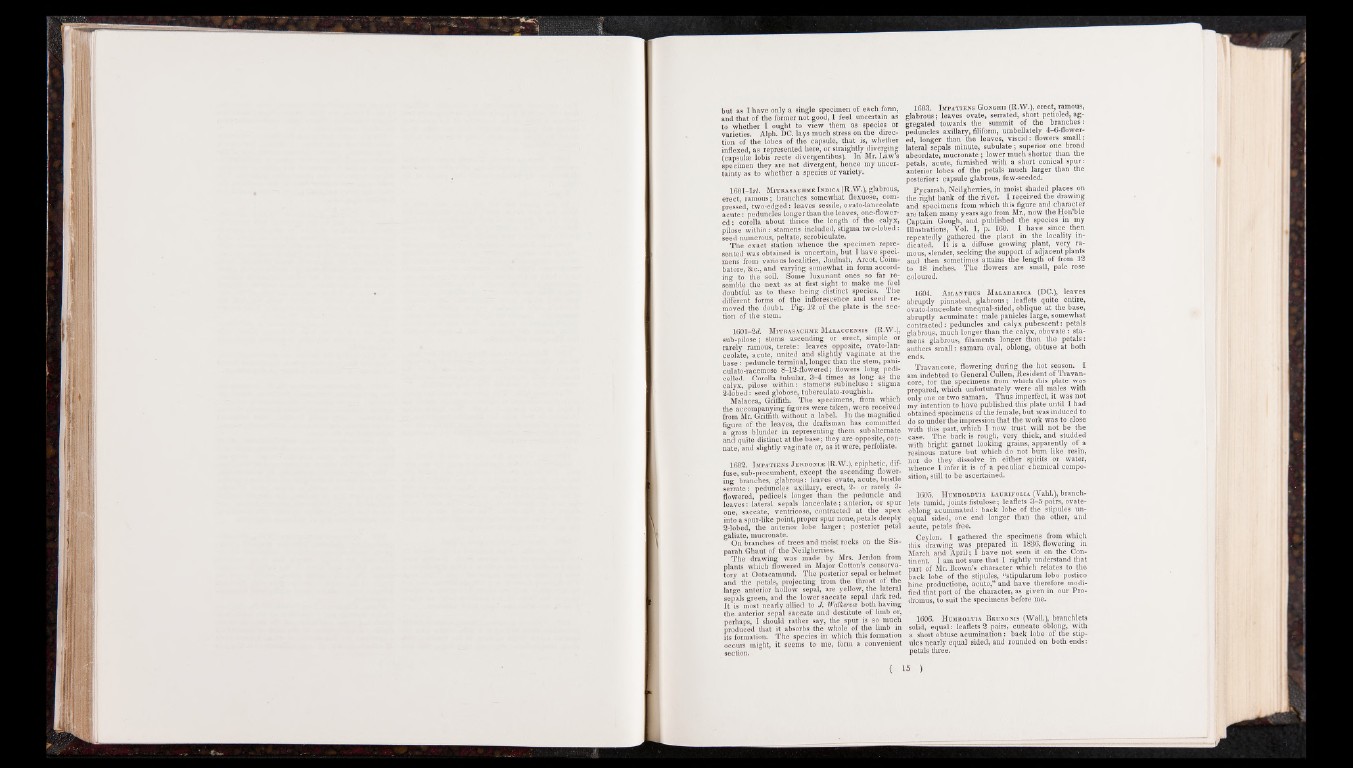
but as I have only a single specimen of each form,
and that of the former not good, 1 feel uncertain as
to whether I ought to view them as species or
varieties. Alph. DC. lays much stress on the direction
of the lobes of the capsule, that is, whether
inflexed, as represented here, or straightly diverging
(capsul* lobis recte divergentibus). In Mr. Law’s
specimen they are not divergent, hence my uncertainty
as to whether a species or variety.
1601-lsi. Mitrasachme Indica (R.W.), glabrous,
erect, ramous; branches somewhat flexuose, compressed,
two-edged: leaves sessile, ovato-lanceolate
acute: peduncles longer than the leaves, one-flowered:
corolla about thrice the length of the calyx,
pilose within: stamens included, stigma two-lobed:
seed numerous, peltate, scrobiculate.
The exact station whence the specimen represented
was obtained is uncertain, but I have specimens
from various localities, Jaulnah, Arcot, Coimbatore,
&c., and varying somewhat in form according
to the soil. Some luxuriant ones so far resemble
the next as at first sight to make me feel
doubtful as to these being distinct species. The
different forms of the inflorescence and seed removed
the doubt Fig. 12 of the plate is the section
of the stem.
1601-2d. Mitrasachme Malaccensis (R.W.),
sub-pilose; stems ascending or erect, simple or
rarely ramous, terete: leaves opposite, ovato-lanceolate,
acute, united and slightly vaginate at the
base: peduncle terminal, longer than the stem, pani-
culato-racemose 8- 12-flowered; flowers long pedi-
ceUed. Corolla tubular, 3 -4 times as long as the
calyx, pilose within: stamens subincluse: stigma
2-lobed: seed globose, tuberculato-roughish.
Malacca, Griffith. The specimens, from which
the accompanying figures were taken, were received
from Mr. Griffith without a label. In the magnified
figure of the leaves, the draftsman has committed
a gross blunder in representing them subalternate
and quite distinct at the base; they are opposite, connate,
and slightly vaginate or, as it were, perfoliate.
1602. Impatiens Jerdonias (R.W.), epiphetic, diffuse,
sub-procumbent, except the ascending flowering
branches, glabrous: leaves ovate, acute, bristle
serrate: peduncles axillary, erect, 2- or rarely 3-
flowered, pedicels longer than the peduncle and
leaves: lateral sepals lanceolate; anterior, or spur
one, saccate, ventricose, contracted at the apex
into a spur-like point, proper spur none, petals deeply
2-lobed, the anterior lobe larger; posterior petal
galiate, mucronate.
On branches of trees and moist rocks on the Sis-
parah Ghaut of the Neilgherries.
The drawing was made by Mrs. Jerdon from
plants which flowered in Major Cotton’s conservatory
at Ootacamund. The posterior sepal or helmet
and the petals, projecting from the throat of the
large anterior hollow sepal, are yellow, the lateral
sepals green, and the lower saccate sepal dark red.
It is most nearly allied to J. Walkerece both having
the. anterior sepal saccate and destitute of limb or,
perhaps, I should rather say, the spur is so much
produced that it absorbs the whole of the limb in
its formation. The species in which this formation
occurs might, it seems to me, form a convenient
section.
1603. Impatiens Gonghii (R.W.), erect, ramous,
glabrous; leaves ovate, serrated, short petioled, aggregated
towards the summit of the branches:
peduncles axillary, filiform, umbellately 4-6-flower-
ed, longer than the leaves, viscid: flowers small;
lateral sepals minute, subulate; superior one broad
abcordate, mucronate; lower much shorter than the
petals, acute, furnished with a short conical spur:
anterior lobes of the petals much larger than the
posterior: capsule glabrous, few-seeded.
Pycarrah, Neilgherries, in moist shaded places on
the right bank of the river. I received the drawing
and specimens from which this figure and character
are taken many years ago from Mr., now the Hon’ble
Captain Gough, and published the species in my
Illustrations, Vol. 1, p. 160. I have since then
repeatedly gathered the plant in the locality indicated.
It is a diffuse growing plant, very ramous,
slender, seeking the support of adjacent plants
and then sometimes attains the length of from 12
to 18 inches. The flowers are small, pale rose
coloured.
1604. Ailanthus Malabarica (DC.), leaves
abruptly pinnated, glabrous; leaflets quite entire,
ovato-lanceolate unequal-sided, oblique at the base,
abruptly acuminate: male panicles large, somewhat
contracted: peduncles and calyx pubescent: petals
glabrous, much longer than the calyx, obovate : stamens
glabrous, filaments longer than the petals:
anthers small: samara oval, oblong, obtuse at both
ends.
Travancore, flowering during the hot season. I
am indebted to General Cullen, Resident of Travancore,
for the specimens from which this plate was
prepared, which unfortunately were all males with
only one or two samara. Thus imperfect, it was not
my intention to have published this plate until I had
obtained specimens of the female, but was induced to
do so under the impression that the work was to close
with this part, which I-now trust will not be the
case. The bark is rough, very thick, and studded
with bright garnet looking grains, apparently of a
resinous nature but which do not burn like resin,
nor do they dissolve in either' spirits or water,
whence I infer it is of a peculiar chemical composition,
still to be ascertained.
1605. Humboldtia latjrifolia (Vahl.), branch-
lets tumid, joints fistulose; leaflets 3-5-pairs, ovate-
oblong acuminated: back lobe of the stipules unequal
sided, one end longer than the other, and
acute, petals free.
Ceylon. I gathered the specimens from which
this drawing was prepared in 1836, flowering in
March and April; I have not seen it on the Continent.
I am not sure that I rightly understand that
part of Mr. Brown’s character which relates to the
back lobe of the stipules, “stipularum lobo postico
hinc productione, acuto,” and have therefore modified
that part of the character, as given in our Pro-
dromus, to suit the specimens before me.
1606. Humboltia Brunonis (Wall.), branchlets
solid, equal: leaflets 2 pairs, cuneate oblong, with
a short obtuse acumination: back lobe of the stipules
nearly equal sided, and rounded on both ends:
petals three.